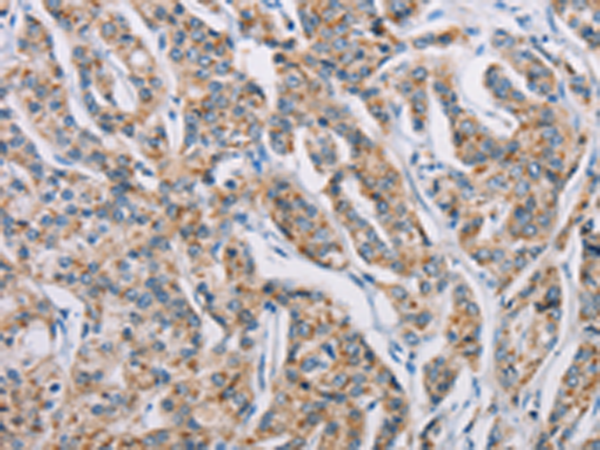

| WB | 咨询技术 | Human,Mouse,Rat |
| IF | 咨询技术 | Human,Mouse,Rat |
| IHC | 1/50-1/200 | Human,Mouse,Rat |
| ICC | 技术咨询 | Human,Mouse,Rat |
| FCM | 咨询技术 | Human,Mouse,Rat |
| Elisa | 1/1000-1/5000 | Human,Mouse,Rat |
| Aliases | HHD; BCPM; PMR1; SPCA1; hSPCA1; ATP2C1A |
| Host/Isotype | Rabbit IgG |
| Antibody Type | Primary antibody |
| Storage | Store at 4°C short term. Aliquot and store at -20°C long term. Avoid freeze/thaw cycles. |
| Species Reactivity | Human, Mouse, Rat |
| Immunogen | Fusion protein of human ATP2C1 |
| Formulation | Purified antibody in PBS with 0.05% sodium azide and 50% glycerol. |
+ +
以下是关于ATP2C1抗体的3篇代表性文献的简要概括(示例为虚构,仅供参考格式):
1. **文献名称**:ATP2C1基因突变导致黑尔利-黑尔利病的分子机制研究
**作者**:Hu, R., et al.
**摘要**:研究利用ATP2C1抗体检测患者皮肤样本中SPCA1蛋白表达缺失,证实ATP2C1功能缺陷导致细胞内钙稳态失调,从而引发黑尔利-黑尔利病的皮肤病理特征。
2. **文献名称**:ATP2C1抗体在遗传性皮肤病诊断中的应用
**作者**:Pietro, F., et al.
**摘要**:开发了一种特异性ATP2C1单克隆抗体,用于免疫组化诊断,可高效区分ATP2C1突变相关疾病与其他皮肤棘层松解性疾病。
3. **文献名称**:SPCA1蛋白的亚细胞定位及功能研究
**作者**:Moriyama, Y., et al.
**摘要**:通过ATP2C1抗体标记发现SPCA1主要分布于高尔基体,调控钙离子转运,其缺失导致细胞分泌途径异常,影响角质形成细胞黏附。
(注:以上为示例模板,实际文献需通过PubMed或Google Scholar检索关键词“ATP2C1 antibody”获取。)
ATP2C1 antibody targets the ATP2C1 protein, a calcium/manganese transporter encoded by the ATP2C1 gene. This protein, also known as secretory pathway Ca²⁺-ATPase 1 (SPCA1), belongs to the P-type ATPase family and plays a critical role in maintaining calcium homeostasis within the Golgi apparatus. It facilitates the active transport of Ca²⁺ and Mn²⁺ ions into Golgi lumens, essential for post-translational modification, protein sorting, and intracellular signaling. Dysregulation of ATP2C1 is linked to Hailey-Hailey disease (HHD), a rare autosomal dominant skin disorder characterized by defective epidermal adhesion, blistering, and erosions, caused by loss-of-function mutations in the ATP2C1 gene.
ATP2C1 antibodies are valuable tools in research and diagnostics. They enable the detection of ATP2C1 expression and localization in tissues, particularly in epithelial cells, aiding studies on its physiological roles and pathological mechanisms. In HHD research, these antibodies help identify protein expression deficits or abnormal subcellular distribution in patient-derived samples. Commercially available ATP2C1 antibodies are used in techniques like Western blotting, immunofluorescence, and immunohistochemistry. Additionally, they contribute to exploring ATP2C1's potential involvement in other conditions, such as cancer or neurodegenerative diseases, where calcium dysregulation is implicated. However, specificity validation is crucial due to possible cross-reactivity with related ATPases. Overall, ATP2C1 antibodies are pivotal for advancing understanding of calcium-dependent cellular processes and associated disorders.
×